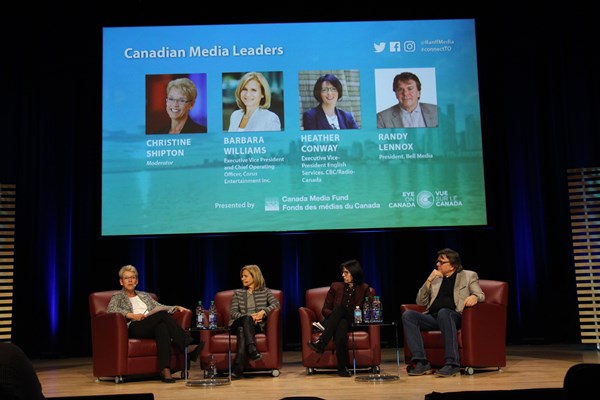Media execs weigh in on working with Netflix
Heads from CBC, Corus and Bell on why a deal with the SVOD can be like "sleeping with the enemy," issues with funding premium content and the challenges they face for ad dollars.

When a panel of Canada’s top media executives gathered Thursday to discuss industry issues, the conversation inevitably turned to Netflix.
“The percentage of homes that Netflix is in and the amount of tuning that’s going – they kind of slid under the radar a bit, but when you dig into it, it’s pretty spectacular,” Barb Williams, EVP and COO of Corus Entertainment said during the media leaders panel at the Banff World Media Festival’s Connect TO event at the Glenn Gould Studio in Toronto.
The stiff competition for viewership that Netflix and other SVODs present was brought up several times throughout the course of the panel, which was moderated by former Shaw Media COO Christine Shipton. Joining Williams on stage were Heather Conway, EVP of English Services at CBC and Randy Lennox, newly appointed president of Bell Media.
“Netflix is a very, very, very powerful force in this country, never mind the world, from a content point of view. And [partnering with it to create content] is sleeping with the enemy. And they are the enemy,” Williams said.
She added that while Corus will partner with Netflix again on season two of Travelers, and perhaps other series in the future, the media company is trying to figure out the right balance to financing premium quality content.
“We’re all acknowledging that we can make [great content] if we get the money to do it. But who are the right partners and what are the right terms? What is a win in the short term but might be very damaging in the long term?” she said. “Maybe you could do one or two [shows] with them, but you don’t want your whole slate with [Netflix].”
Conway added that two seasons of House of Cards cost $100 million, nearly the entire annual non-news budget of the pubcaster. With regards to the CBC’s partnerships with Netflix on two upcoming series, Anne and Alias Grace, she said the SVOD’s participation meant CBC had significantly higher budgets to work with. “To compete with the quality of content, it does cost money,” she said. “That’s not to say that Canadian creators can’t compete, but Canadian creators aren’t often given the kind of budget that allows them to compete. [So] leveraging what we have through partnerships gives our creators a chance to do that.”
Lennox noted, however, that the virtual duopoly that Netflix and Hulu present puts Canadian broadcasters at a slight disadvantage. “We did a 50/50 joint venture on Frontier with Netflix and we are doing Russell Peters’ The Indian Detective with Netflix, so we certainly aren’t precluding it, but I’d sure rather have six or seven [SVODs] than one or two [vying for our content] because the terms can be strenuous in terms of those deals.”
(At this point, a man in the audience, which was largely comprised of producers, said, “Now you know how I feel,” presumably referencing the broadcasting oligopoly in Canada.)
While OTT platforms certainly present serious competition for eyeballs and are forcing traditional broadcasters to invest more in content, Conway added SVODs are also conditioning audiences to be “adlergic.”
“We are training the audience through the OTT experience to have a low tolerance for advertising,” she said.
She added that the issue facing broadcasters isn’t TV dollars being replaced by “digital dimes,” it’s that there are so many competitors in the digital space.
“When you’re buying display video on digital you’re paying the same CPMs as you are for TV now. The big challenge is most of that inventory still gets eaten up by YouTube, by Facebook ads, Facebook video. Your competitors are now moving into that lucrative space in digital that is video and we’re all limited because the inventory that [we] can make available is not as great as the others have,” she said.
Fewer ad dollars means fewer dollars for content, she added. So with ad dollars harder to come by, broadcasters are looking for alternative sources of revenue.
Lennox gave the example of Bell Media’s recent partnership with Iconic Entertainment Studios to produce Bat Out of Hell: The Musical.
He noted that Bell is working with broadcasters around the world to air the live theatre performance on television, in the same way that NBC aired its Grease and Hairspray live events on linear. In addition to signing broadcast partnerships for the theatre event, Bell also has the merchandizing rights to the event – another added source of revenue.
While Lennox and Williams explained the new ways in which their companies are working with partners to increase revenues, Conway took the time to remind the audience that CBC has submitted a proposal to Canadian Heritage to transition to an ad-free model.
“In as much as we do value our advertisers today, our model in the future is we would like to get out of [advertising],” she said.
To which Lennox replied, “We would like you to, too.”
Conway added that by going ad-free, the CBC could focus on its cultural mandate and at the same time give a boost to private broadcasters.
“The study that we commissioned from Nordicity does show that two-thirds of our ad revenue would migrate to two companies,” she said. “It would be helpful, I think, to have those funds, as we are all are struggling with the transitions that we’ve talked about. The public broadcaster doesn’t have to be in that space.”

 The definitive CDN broadcast and production resource.
The definitive CDN broadcast and production resource.










